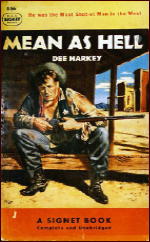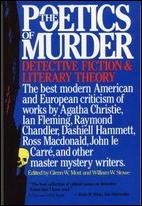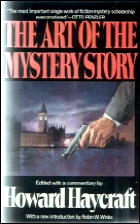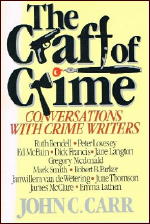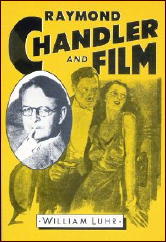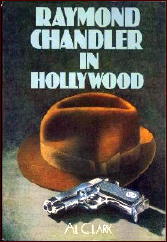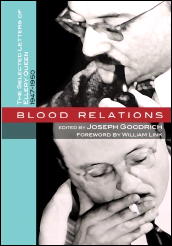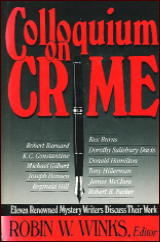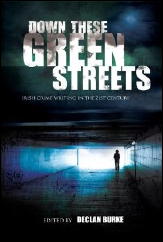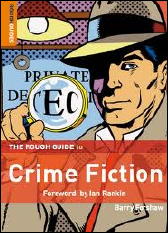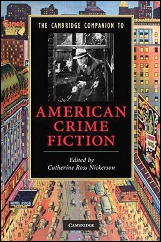WE ARE ALL SENTIMENTALISTS NOW:
Leonard Cassuto’s Hard-Boiled Sentimentality:
The Secret History of American Crime Stories
by Curt J. Evans
Over the last twenty years feminist literary scholars have leaped into the field of mystery criticism with great energy and enthusiasm; and they have had a remarkable impact on it. In Great Britain, such academic authorities as Gill Plain, Susan Rowland and Merja Makinen have written perceptive revisionist studies on British Golden Age “Crime Queens†(Agatha Christie, Dorothy L. Sayers, Margery Allingham and Ngaio Marsh), defending them from the traditional (usually male) criticism, dating back to Raymond Chandler and Edmund Wilson in the 1940s and prevalent through the early Marxist-influenced academic monographs of the 1970s, that their work is insipid, reactionary drivel, in contrast with the admirable, socially progressive and genre transcending American hard-boiled fiction most famously associated with Dashiell Hammett and Raymond Chandler himself.
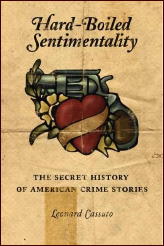
This scholarly feminist emphasis on the Crime Queens, while important in revising earlier masculinist views of these authors, has led to the elevation of an increasingly commonplace view within academia, namely that the mystery genre in Britain during the Golden Age was essentially feminine, representing a purportedly distinct and uniquely female set of values, such as the privileging of feelings and intuitions over material detail (i.e., psychology over footprints and timetables), a preference for cerebration over fisticuffs as the way of reaching solutions to problems and an emphasis on domestic detail and the inter-connectedness of individuals. “All in all,†emphatically concludes Susan Rowland in a representative statement from a recent essay, “the golden age form is a feminized one.â€
[Susan Rowland, “The ‘Classical’ Model of the Golden Age,†in Lee Horsley and Charles A. Rzepka, eds.,
A Companion to Crime Fiction (Wiley-Blackwell, 2010), 122.]
Thus portrayed, “feminine†English Golden Age detective fiction starkly contrasts with the “masculine†hardboiled form that frequently has been taken to represent American detective fiction during this period (roughly 1920 to 1939) — though the critical estimation of English Golden Age detective fiction (or, to be more precise, the four women authors often portrayed as nearly entirely representing it) has been considerably raised.
However, another feminist literary scholar — this time an American, Catherine Ross Nickerson — has pointed out in an important 1998 study, The Web of Iniquity: Early Detective Fiction by American Women, that detective fiction in the United States was not actually a strictly masculine preserve, a playground for the tough guys. Rather, Nickerson has shown, an indigenous American tradition of female-authored crime fiction existed well back into the nineteenth century.
One of the writers she discusses, Mary Roberts Rinehart, was active and extremely popular in the United States all though the Golden Age (indeed, she was much more significant at this time than Raymond Chandler, who only published his first novel in 1939, at the very tail-end of the Golden Age, confining himself before that to pulp short stories).
But although Professor Nickerson helped remind her academic colleagues that women mystery writers with their own narrative style and literary concerns not only existed but were much read in the United States in the 1920s and 1930s, it remained for Professor Leonard Cassuto to do something that no other academic had yet done: perceive the American hardboiled detective novel itself as feminized.
[Academic scholars continue to mostly overlook detective novelists in both the United States and Great Britain who did not write in the hardboiled style and were not women, but that is the subject for another essay!]
Leonard Cassuto’s Hard-Boiled Sentimentality: The Secret History of American Crime Stories (Columbia University Press, 2008) is one of the most highly praised academic crime literature monographs of the last decade. “Superb…fresh insights on every page,†declares Alan Trachtenberg of Yale University.
Not to be outdone is crime writer Julia Spencer-Fleming, who provides a blurb that is surely one to die for: “Hard-Boiled Sentimentality is a nonfiction epic that reads like the best genre fiction, tracing the bloodlines of crime fiction from Sam Spade to Hannibal Lecter. Cassuto’s scholarship is impeccable; his narrative voice magnetic. A must-read for every student of genre fiction and the go-to source for the evolutionary history of the genre.â€
Whew! Is it really as good as all that? In my view, not quite; though Cassuto makes an interesting (if not invariably persuasive) argument and his writing is comprehensible and refreshingly jargon-light, not something that can be said for many of the academic monographs in this field. Hard-Boiled Sentimentality often is quite insightful and for those interested in hardboiled fiction it should make rewarding reading.
[Despite the zealous claim that
Hard-Boiled Sentimentality reads as grippingly as the best crime novels, sentences like “this refusal to speculate aligns Spade with some of the reformist political positions of the Progressive era†do not trip off the tongue. To be fair to Cassuto, however, I cannot recall any academic monograph that reads just like a crime novel.]
Leonard Cassuto contends that rather than being “masculinist†tales of unfeeling lone tigers prowling in the asphalt jungle, hard-boiled novels in reality are closely related to women’s sentimental domestic fiction of the nineteenth century, which “celebrates the reliable and nourishing social ties that result when people extend their sympathy to others around them.â€
In Cassuto’s view, hard-boiled tales “engage with a domestic sentimentalism born of a specific historical period†and it is this “engagement with the nineteenth-century sentimental†that “shapes the history and evolution of the hard-boiled from its inception to the present day.†“Inside every crime story is a sentimental narrative that’s trying to come out,†declares Cassuto provocatively. “Sentimentalism invented the American crime novel.â€
Over the course of his study, which extends from the 1920s to the present day, Cassuto explicates the key role he sees sentimentalism as having played in the shaping of the American crime tale. Chapter One deals with the influence exercised on the hard-boiled school of crime writing by mainstream novelists Theodore Dreiser and Ernest Hemingway.
Chapter Two looks at Dashiell Hammett. Relying on his reading of The Maltese Falcon (and to a lesser extent Red Harvest and The Dain Curse), Cassuto argues that Hammett portrays “sentimentalism in ruins: a world of self-interested individuals cut loose from family ties and family obligations, who have abandoned sympathy to chase the dollar.â€
However he emphasizes that in The Maltese Falcon tough-as-nails detective Sam Spade struggles between “self-interest and sympathy†and that in The Dain Curse the Continental Op “shows genuine concern for his young charge [Gabrielle Leggett].â€
Chapter Three sees Cassuto taking on “Depression Domesticity,†primarily through James M. Cain’s Mildred Pierce and Raymond Chandler’s The Big Sleep and The High Window.
With its family saga of a deluded mother and her deceiving daughter, writes Cassuto, Mildred Pierce allows James M. Cain to bring “the sentimental and the hard-boiled into the same house.†It offers readers “the key to the hard-boiled engine-room.â€
Chandler’s detective Philip Marlowe, for his part, is in Cassuto’s view driven primarily by a need to put broken houses back together, restoring families to that portion of harmony still possible in 1930s America. As an author, asserts Cassuto, Chandler was “in quixotic pursuit of a family ideal that was being threatened during the Depression, when financial hardship broke many families apart.â€
Chapter Four, which takes us past World War Two and into the 1950s and the Cold War, sees Cassuto considerably expanding his analytical net, taking in a wider range of novels, including those by Chandler, Mickey Spillane, David Goodis, John D. MacDonald, William P. McGivern, Wade Miller, “John Evans†(Howard Browne), Gil Brewer and Cornell Woolrich.
“Working from the model provided by Raymond Chandler,†explains Cassuto, “postwar crimefighters become passionate and involved defenders of home and hearth.†Cold War paranoia and the desire to restore traditional gender roles after global conflagration had menaced world order combined to create the fetching but fearsome femme fatale, a creature in Cassuto’s view that is most notable for her refusal to accept what was seen as her natural role in the social order, that of domesticated wife and mother.
“A veritable army of unpredictable femmes fatales, armed and dangerous and set to destroy home and community, swarms out of the crime stories of the 1950s,†Cassuto writes colorfully. He is especially interesting here on the hard-boiled novel’s treatment of lesbians and transsexuals, who represented the ultimate in “female†transgression.
Even Cassuto’s creativity at finding sentimentality in every hard-boiled cavity he searches is stymied by those deviant and demented darlings of modern critics, Patricia Highsmith and Jim Thompson, however; and in Chapter Five, “Sentimental Perversion,†he shows how these compellingly idiosyncratic authors subversively undermined sentimentalism at every opportunity.
To be sure, sentimentality makes a considerable comeback in Chapter Six, where Cassuto looks at the work of Ross Macdonald, John D. MacDonald and (to a much lesser extent) Robert B. Parker. Anyone familiar with Ross Macdonald’s novels knows they changed over time, as Macdonald shook off the influence of Chandler (who was quite cutting in his appraisal of the younger man’s work) and allowed his own personal preoccupations to take hold of his narratives.
Making use of Tom Nolan’s fine biography of Macdonald, Cassuto is able to show how the author’s family problems meshed with the therapeutic culture of the 1960s to lead Macdonald to produce book after book on household dysfunction and the generation gap, with Macdonald’s series detective, Lew Archer, acting as a sort of family therapist (or as Cassuto writes, “a kind of walking vessel for collective guilt†and “an everyman of sympathyâ€).
For Cassuto Ross Macdonald “stands as perhaps the most sentimental of all hard-boiled novelists because he understands family ties in the same way the sentimental writers did a century before him.†Similarly, Cassuto believes the robust if offbeat home life (aboard a Fort Lauderdale houseboat called the Busted Flush) of John D. MacDonald’s detective Travis McGee firmly affiliates this author’s work with the sentimental side of life, since his detective is not office-centered like Sam Spade and Philip Marlowe.
Dealing with, respectively, female private eyes and race in the hard-boiled novel, Chapter Seven and Eight feel somewhat tacked on, but Cassuto returns in full force with a discussion of the serial killer and the crime novel in his monograph’s final chapter. Contrary to what we might think, serial killer novels also reflect sentimentalist hegemony, according to Cassuto. The serial killer should be understood as “an anti-family man,†Cassuto declares. “He is purely anti-sympathy, anti-domesticity, anti-sentimentality.†And opposing him is the increasingly sensitive and domesticated detective.
At one point in his book, Cassuto forcefully criticizes scholars’ “static and stereotyped conception of hard-boiled masculinity.†He rightly notes that this conception has arisen to a great extent from ingenuous readings of Raymond Chandler’s polemical 1946 essay, “The Simple Art of Murder,†which stridently emphasizes the tough masculinity of hard-boiled heroes by “feminizing the genteel detective story tradition.â€
To be sure, other critics before Cassuto have discerned a certain amount of hollow chest-beating bravado in Chandler’s essay. The great centenarian scholar Jacques Barzun, for example, noted forty years ago in the introduction to his and Wendell Hertig Taylor’s A Catalogue of Crime (Harper & Row, 1971) that Chandler in notable ways was himself a “sentimental [emphasis added] tale spinner†(p.11), whatever claims he made to the contrary in “The Simple Art of Murder.â€
Still, in forcefully challenging the “static and stereotyped conception of hard-boiled masculinity†with his lengthy study Cassuto deserves our praise. Nevertheless, I think that his admirable zeal to revise error sometimes pushes Cassuto to overstate his case, rendering an over-sentimentalized (or overly-feminized) interpretation of the hard-boiled crime novel.
Cassuto’s coverage of hard-boiled fiction in the 1920s, 1930s and 1940s is sparser than I would have expected from an author advancing such an ambitious, overarching thesis. A number of significant tough crime writers of the period are short-shrifted (Raoul Whitfield) or ignored entirely (Jonathan Latimer).
Despite his fine discussion of Mildred Pierce, never does Cassuto convince me that James M. Cain’s admired novel truly is “the key to the hard-boiled engine room†(on the other hand, it is the work that most strongly supports his thesis). Does Mildred Pierce unlock Jonathan’s Latimer scabrously humorous The Lady in the Morgue (its repertoire includes necrophilia jokes about the lady missing from the morgue), for example?
While Cassuto provides some analysis of how James M. Cain’s The Postman Always Rings Twice and Double Indemnity (as well as Horace McCoy’s They Shoot Horses, Don’t They?) fit into his thematic structure, he largely omits consideration of the short stories of Hammett and Chandler, as well as Hammett’s novels The Glass Key and The Thin Man and Chandler’s novels Farewell, My Lovely, The Lady in the Lake and The Little Sister. (Playback is not here either, but who can really complain about that.)
These are significant omissions when one considers the small output of novels from the hard-boiled twin titans. In his entry on the novel in 1001 Midnights, Francis M. Nevins has written of The Glass Key that “its third-person narrative voice … is so objectively realistic and passionlessly impersonal that it seems to draw an impenetrable shield between character and reader.â€
Does Cassuto find sympathy in The Glass Key? In regard to Chandler, are his novels Farewell, My Lovely and The Lake in the Lake, published about the same time as The Big Sleep and The High Window, about Marlowe as a fixer of broken families? It would have been nice to see Cassuto’s thoughts on how these particular novels develop his themes.
[Bill Pronzini and Marcia Muller, eds.,
1001 Midnights: The Aficionado’s Guide to Mystery and Detective Fiction (Arbor House, 1986), 335.
In
Hard-Boiled Sentimentality, Chandler’s
The Big Sleep is discussed on a dozen pages,
The High Window on a half-dozen and
The Long Goodbye on three, while
Farewell, My Lovely is mentioned once (and this only in reference to its 1940s sales) and
The Lady in the Lake and
The Little Sister no times at all.
While doubtlessly
The High Window better illustrates Cassuto’s sentimental domesticity thesis than, say,
Farewell, My Lovely (where in my reading the strongest sentimental feelings are directed at single men),
The High Window certainly is not inherently a more “important†book in the Chandler canon than
Farewell, My Lovely. (Indeed, most critics clearly deem
Farewell, My Lovely to be markedly superior to
The High Window as a piece of literature.)
Similarly, Cassuto discusses Hammett’s
The Maltese Falcon on nearly thirty pages,
Red Harvest on seven and
The Dain Curse on six, while failing to mention the highly-praised
The Glass Key. Certainly
The Glass Key is considered a richer work than
The Dain Curse, which is almost universally regarded as Hammett’s poorest novel.]
Further, Cassuto’s attribution of causality for the way the narratives develop in the Hammett and Chandler novels he does write about sometimes is debatable. For example, Hammett’s vivid fictional world of grasping, self-interested and self-regarding individuals may owe more to the author’s engagement with Karl Marx than with Harriet Beecher Stowe.
Similarly, it seems to me that much of the thematic content in Chandler’s novels is derived from his marked resentment (personal, not ideological) of the idly wealthy and his deep sense of masculine honor. In my view, Marlowe’s sympathy in The Big Sleep is reserved for old General Sternwood, not his corrupted daughters.
Any repairing of the General’s home necessarily involves driving the insanely murderous and nymphomaniacal Carmen Sternwood from its precincts. (It is important to recall here the famous image of the stained-glass window in the Sternwood home depicting the knight battling the dragon, i.e., serpent — the serpent in the Sternwood home is Carmen, who even hisses at one point.)
As the critic Clive James has perceptively noted, “Carmen is the first in a long line of little witches that runs right through the [Chandler] novels, just as her big sister, Vivian, is the first in a long line of rich bitches who find that Marlowe is the only thing money can’t buy.â€
[Clive James, “Raymond Chandler,†in
As of this Writing: The Essential Essays, 1968-2002 (W. W. Norton, 2003), 204.]
Marlowe (who assuredly represents his creator) does not expend a lot of sentiment or sympathy either on the little witches or the rich bitches, those fallen temptresses and potential destroyers of men.
Certainly Chandler’s little witches are those les belle dames sans merci of hardboiled mystery, the femmes fatales (they appear — quite memorably — in Farewell, My Lovely and The Lady in the Lake as well, novels Cassuto does not discuss).
This fact alone leads me to question Cassuto’s assessment of the femme fatale primarily as a 1950s phenomenon. Cassuto himself admits that The Maltese Falcon offers a prominent example of the femme fatale, but the willful creature also rears her lovely head, as indicated above, numerous times in the works of Raymond Chandler, not to mention forties film noir, as well as other hard-boiled tales by the many 1940s writers not discussed by Cassuto.
Surely the explosion of the femme fatale phenomenon in this period was set off in part simply by the paperback revolution and the dramatic discovery that more explicit sexualization of women helped sell hardboiled books to male readers. In his book Hard-Boiled America, Geoffrey O’Brien perceptively highlights the impact of World War 2 in this context:
Wars in America have generally led to a relaxation of sexual censorship; for instance, the public acceptance of
Penthouse and
Hustler can probably be traced to the Vietnam War. Likewise the returning GIs of the 1940s craved stronger stuff than Betty Grable pinups…. With all the energy of an industry undergoing rapid development, the paperbacks — free of the constraints that hampered movies and radio — resolutely pushed the limits…. Encouraged by rising sales figures, [paperbacks] were no longer playing by the same rules (An illustrator whose career began in the postwar period recalls, “The word went out — get sex into it somehow.â€)
[Geoffrey O’Brien,
Hard-Boiled America (Da Capo Press, 1997) (expanded edition; originally published 1981).]
In short, sometimes hardboiled fiction surely engaged more directly with sexuality than sentimentality. (Certainly the lurid paperback covers did.) In Chandler’s case, the continual resort to the device of the femme fatale appears to have arisen more out of personal issues than national social and economic concerns (as does the distaste for homosexuals Chandler expresses though Marlowe in The Big Sleep), so once again Cassuto’s approach (e.g., traditional family rhetoric and the Cold War made them do it) seems overly mechanistic.
It should be noted that where it supports his thesis that a given hardboiled author is sentimental (Ross Macdonald in this case), Cassuto does resort in part to personal biography for answers as to why the author wrote as he did. Doing so makes his argument more persuasive (indeed, the Ross Macdonald section is one of the strongest in the book).
Sometimes Cassuto can be heavy-handed in his approach to causal factors. Could The Maltese Falcon or The Big Sleep have come into existence without Adam Smith’s The Wealth of Nations, which observed the role self-interest played in guiding human endeavor, or his The Theory of Moral Sentiments, which analyzed sympathy?
Apparently they could not have, according to Cassuto. “Adam Smith may be considered the founding father of both sympathy and the hard-boiled attitude at the same time,†Cassuto rather breezily pronounces. “Smith published perhaps the foundational hard-boiled text, The Wealth of Nations, in 1776…. But Smith was already an expert on sympathy at the time he wrote his anatomy of capitalistic individualism; in 1759 he wrote The Theory of Moral Sentiments.â€
Such speculation led me idly to wonder how it is that Adam Smith never wrote a hardboiled crime novel. Had he done so, it inevitably would have been called, one imagines, The Invisible Hand.
[If Adam Smith is the “founding father†of sympathy, where does Jesus Christ fit into the picture?]
Despite these criticisms on my part, I think Cassuto has a valuable thesis overall. Academic analysts have tended to overly polarize male hard-boiled authors and female crime fiction writers (as well as traditional male detective novelists).
Thus I would recommend the perusal of Hard-Boiled Sentimentality by those interested in better understanding crime fiction. Yet I must also add a few more criticisms of the book that are of a different nature, stemming from Professor Cassuto’s evident lack of familiarity with the history of the mystery genre on certain points. (He is by no means alone among academic scholars in this regard.)
First, although he references Catherine Ross Nickerson’s The Web of Iniquity, rarely does Cassuto mention women crime writers before 1970 (Patricia Highsmith is the notable exception). In her review of Hard-Boiled Sentimentality, Sarah Weinman criticized Cassuto’s omission of Dorothy B. Hughes’ In a Lonely Place (1947) as “particularly startling†because “this novel seems to prove Cassuto’s thesis conclusively.â€
[Sarah Weinman, “Sentimental Tough Guys,â€
Los Angeles Times, 17 October 2008. Since in a footnote Cassuto briefly refers to the author’s handling of a serial killer in
In a Lonely Place, his failure to integrate the novel into the main body of his study clearly is deliberate, not inadvertent.]
I understand that Cassuto presumably wanted to focus on male hard-boiled writers rather than female ones, because the response to the inclusion of such a writer as Dorothy B. Hughes might well have provoked the response, “of course she wrote with sympathy, she was a woman!â€
Yet the omission of so many women writers does leave a sort of vacuum on those occasions when the author makes rather sweeping statements. When Cassuto writes that the “male heroes of most fifties crime novels … assume the protective role that women played in sentimental fiction of the previous century,†I could not help wondering what was going on in the fifties crime novels written by women. (In the works of women writers of 1950s “psychological suspense,†for example, one cannot always be sure of those “male heroes.â€)
Second, Cassuto, like most academic literary scholars, perpetuates the myth that Raymond Chandler cared nothing for plotting. In doing so he ironically relies mostly on Chandler’s “The Simple Art of Murder†essay, though elsewhere, as noted above, he chastises other scholars for unquestioningly accepting it. (He also digs up the old chestnut about Chandler not knowing who killed the chauffeur in The Big Sleep when questioned by Howard Hawks and William Faulkner, who were adapting the book to film).
Chandler “rejects the puzzle-whodunit because it’s unrealistic†and “turned away from the intricate plots of the likes of Ellery Queen and S. S. Van Dine because they’re too intellectual to activate the power of sympathy,†asserts Cassuto.
In a 2006 article in the Wall Street Journal, Cassuto is even blunter on this matter. “Raymond Chandler was the rare mystery writer who didn’t care whodunit,†Cassuto peremptorily pronounces in the first sentence of the article. Near the end of it, he asserts that “Chandler’s artistic impulse turns on his rejection of the puzzle mystery.â€
Though Cassuto is hardly alone in diminishing Chandler’s interest in the puzzle mystery (indeed, both Chandler’s biographers do it), he is wrong in doing so. Chandler read and enjoyed the traditionalist British detective novelists R. Austin Freeman and Freeman Wills Crofts (though he hated the debonair gentleman sleuths of the British Crime Queens and thought Agatha Christie was unfair to the reader), envied the plotting skill of Perry Mason creator Erle Stanley Gardner and composed, in the same decade as he wrote “The Simple Art of Murder,†a set of rules for writing mystery fiction that in many respects is as orthodox as those famously devised by Englishman Ronald Knox.
Further, for someone who purportedly “didn’t care whodunit†and rejected the puzzle mystery, Chandler perversely composed several well-plotted detective novels — praised by the orthodox critic Jacques Barzun — including Farewell, My Lovely, The High Window and The Lady in the Lake.
To be sure, The Big Sleep, his first mystery novel, does have, as scholars so often note, its share of plotting problems (I have never been too sure about that pesky chauffeur’s demise either); but that does not take away from the fact that several of his other novels are impeccably plotted. Chandler found plotting hard to do and groused about doing it, but he never rejected it and he often performed it admirably.
[Leonard Cassuto, “The Hero is Hard-Boiled,â€
Wall Street Journal, 26 August 2006. In his critical study
Raymond Chandler (Twyane, 1986), William Marling observes that Chandler’s novels after
The Big Sleep reveal the author’s “increased attention to plot.â€
He notes that Chandler “often came close to the ‘whodunit’ style of English mystery….than he cared to admit†(p. 104). For more on this subject see my forthcoming essay, “‘The Amateur Detective Just Won’t Do’: The Straight Dope on Raymond Chandler and British Detective Fiction.â€]
Third, Cassuto misunderstands the economics of book publishing in the years before the consummation of the paperback revolution. In Hard-Boiled Sentimentality, Cassuto describes The Big Sleep‘s selling of 12,500 copies as a “rocky debut.†(In his Wall Street Journal article, he earlier characterized such a sale as “meager.â€)
Riffing off this point, he concludes that the novel did not “find an audience†until 1943, when it was published in paperback and sold nearly a half-million copies. But in actuality, hardcover sales of a mystery novel title totaling to 12,500 copies was quite impressive in that era, a time when frugal people mostly borrowed mystery fiction (as opposed to “serious literatureâ€) from rental libraries.
Since presumably libraries purchased a great many of those 12,500 books sold, many thousands more than that number would have read the book in the four years that elapsed before The Big Sleep was published in paperback.
Finally, Cassuto’s references to the classical, puzzle-oriented detective novels of the Golden Age tend to be slighting and misinformed. Cassuto, who so forcefully critiques stereotype in the portrayal of hard-boiled fiction, tends himself to reach for stereotypes when using traditional detective fiction as a foil for the tough (yet tender) stuff.
“Hammett’s detective novels departed from genre tradition by presenting a story — and a set of social problems — unenclosed by a drawing room, a country estate, or any other discrete space,†writes Cassuto, relying on the well-worn but overstated notion that the narratives in traditional detective novels of the Golden Age are invariably confined within what are essentially enclosed stable spaces, usually country houses or villages.
Elsewhere, Cassuto passingly declares that hard-boiled novels “supplanted†puzzle-oriented Golden Age mysteries. While admittedly it is true that the rise of the hard-boiled school was one of the factors that helped break the puzzle’s hegemony over Golden Age crime literature, when (or even whether) hard-boiled tales “supplanted†puzzle mysteries is another question.
To state the most obvious example, the puzzle mysteries of Agatha Christie retain immense global popularity even today. Further, as stated above, the plots of many hardboiled novels in fact feature complicated puzzles. Novels like Raymond Chandler’s The Lady in the Lake or Jonathan Latimer’s The Dead Don’t Care have at their hard-boiled hearts fiendishly clever puzzle plots that would have graced even the diabolically ingenious tales of Agatha Christie and Ellery Queen.
All these matters aside, Cassuto has produced a worthwhile and interesting book. The splendid cover illustration of a steely gun and a beribboned red heart tells it all: the tough and the tender often manage to co-exist in the hardboiled novel.
Although Cassuto at times over-tenderizes the tough crime tale and I am not convinced that his engagement-with-domestic-sentimentalism thesis is the master-key that unlocks the hardboiled engine room (however much it helps reveal to us Mildred Pierce), I personally found in Hard-Boiled Sentimentality many fascinating points to engage me.
